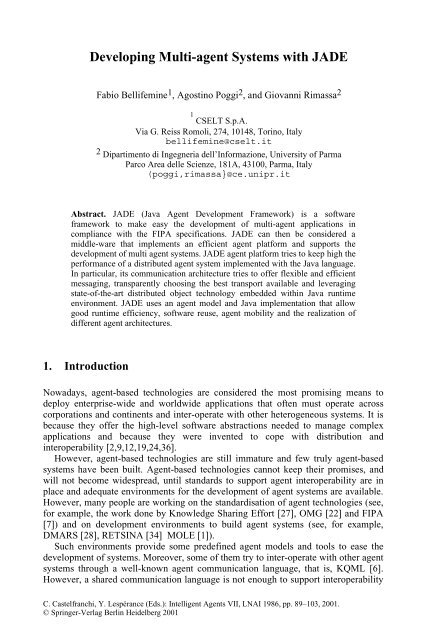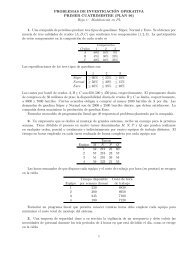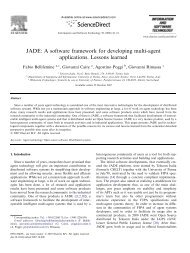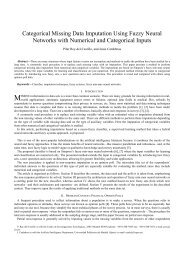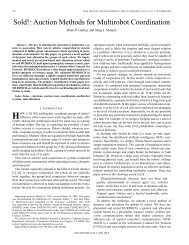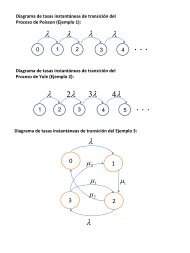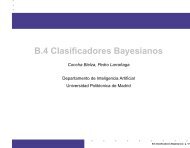Developing multi-agent systems with JADE - CiteSeerX
Developing multi-agent systems with JADE - CiteSeerX
Developing multi-agent systems with JADE - CiteSeerX
- No tags were found...
You also want an ePaper? Increase the reach of your titles
YUMPU automatically turns print PDFs into web optimized ePapers that Google loves.
<strong>Developing</strong> Multi-<strong>agent</strong> Systems <strong>with</strong> <strong>JADE</strong>Fabio Bellifemine 1 , Agostino Poggi 2 , and Giovanni Rimassa 21CSELT S.p.A.Via G. Reiss Romoli, 274, 10148, Torino, Italybellifemine@cselt.it2 Dipartimento di Ingegneria dell’Informazione, University of ParmaParco Area delle Scienze, 181A, 43100, Parma, Italy(poggi,rimassa}@ce.unipr.itAbstract. <strong>JADE</strong> (Java Agent Development Framework) is a softwareframework to make easy the development of <strong>multi</strong>-<strong>agent</strong> applications incompliance <strong>with</strong> the FIPA specifications. <strong>JADE</strong> can then be considered amiddle-ware that implements an efficient <strong>agent</strong> platform and supports thedevelopment of <strong>multi</strong> <strong>agent</strong> <strong>systems</strong>. <strong>JADE</strong> <strong>agent</strong> platform tries to keep high theperformance of a distributed <strong>agent</strong> system implemented <strong>with</strong> the Java language.In particular, its communication architecture tries to offer flexible and efficientmessaging, transparently choosing the best transport available and leveragingstate-of-the-art distributed object technology embedded <strong>with</strong>in Java runtimeenvironment. <strong>JADE</strong> uses an <strong>agent</strong> model and Java implementation that allowgood runtime efficiency, software reuse, <strong>agent</strong> mobility and the realization ofdifferent <strong>agent</strong> architectures.1. IntroductionNowadays, <strong>agent</strong>-based technologies are considered the most promising means todeploy enterprise-wide and worldwide applications that often must operate acrosscorporations and continents and inter-operate <strong>with</strong> other heterogeneous <strong>systems</strong>. It isbecause they offer the high-level software abstractions needed to manage complexapplications and because they were invented to cope <strong>with</strong> distribution andinteroperability [2,9,12,19,24,36].However, <strong>agent</strong>-based technologies are still immature and few truly <strong>agent</strong>-based<strong>systems</strong> have been built. Agent-based technologies cannot keep their promises, andwill not become widespread, until standards to support <strong>agent</strong> interoperability are inplace and adequate environments for the development of <strong>agent</strong> <strong>systems</strong> are available.However, many people are working on the standardisation of <strong>agent</strong> technologies (see,for example, the work done by Knowledge Sharing Effort [27], OMG [22] and FIPA[7]) and on development environments to build <strong>agent</strong> <strong>systems</strong> (see, for example,DMARS [28], RETSINA [34] MOLE [1]).Such environments provide some predefined <strong>agent</strong> models and tools to ease thedevelopment of <strong>systems</strong>. Moreover, some of them try to inter-operate <strong>with</strong> other <strong>agent</strong><strong>systems</strong> through a well-known <strong>agent</strong> communication language, that is, KQML [6].However, a shared communication language is not enough to support interoperabilityC. Castelfranchi, Y. Lespérance (Eds.): Intelligent Agents VII, LNAI 1986, pp. 89–103, 2001.© Springer-Verlag Berlin Heidelberg 2001
90 F. Bellifemine, A. Poggi, and G. Rimassabetween different <strong>agent</strong> <strong>systems</strong>, because common <strong>agent</strong> services and ontology arealso needed. The standardisation work of FIPA acknowledges this issue and, beyondan <strong>agent</strong> communication language, specifies the key <strong>agent</strong>s necessary for themanagement of an <strong>agent</strong> system and the shared ontology to be used for the interactionbetween two <strong>systems</strong>.In this paper, we present <strong>JADE</strong> (Java Agent Development Framework), a softwareframework to write <strong>agent</strong> applications in compliance <strong>with</strong> the FIPA specifications forinteroperable intelligent <strong>multi</strong>-<strong>agent</strong> <strong>systems</strong>. The next section introduces FIPAspecifications. Section three introduces related work on software frameworks todevelop <strong>agent</strong> <strong>systems</strong>. Section four describes <strong>JADE</strong> main features. Section fivedescribes the architecture of the <strong>agent</strong> platform, the communication subsystem.Section six presents <strong>JADE</strong> <strong>agent</strong> model. Finally, section seven concludes <strong>with</strong> a briefdescription about <strong>JADE</strong> main features, the use of <strong>JADE</strong> to realise applications and therelationships between <strong>JADE</strong> and some other <strong>agent</strong> software frameworks.2. FIPA SpecificationsThe Foundation for Intelligent Physical Agents (FIPA) [7] is an international nonprofitassociation of companies and organisations sharing the effort to producespecifications for generic <strong>agent</strong> technologies. FIPA does not just promote atechnology for a single application domain but a set of general technologies fordifferent application areas that developers can integrate to make complex <strong>systems</strong><strong>with</strong> a high degree of interoperability.The first output documents of FIPA, named FIPA97 specifications, state thenormative rules that allow a society of <strong>agent</strong>s to exist, operate and be managed. Firstof all they describe the reference model of an <strong>agent</strong> platform: they identify the roles ofsome key <strong>agent</strong>s necessary for managing the platform, and describe the <strong>agent</strong>management content language and ontology. Three mandatory roles were identifiedinto an <strong>agent</strong> platform. The Agent Management System (AMS) is the <strong>agent</strong> that exertssupervisory control over access to and use of the platform; it is responsible formaintaining a directory of resident <strong>agent</strong>s and for handling their life cycle. The AgentCommunication Channel (ACC) provides the path for basic contact between <strong>agent</strong>sinside and outside the platform. The ACC is the default communication method,which offers a reliable, orderly and accurate message routing service. FIPA97mandates ACC support for IIOP in order to inter-operate <strong>with</strong> other compliant <strong>agent</strong>platforms. The Directory Facilitator (DF) is the <strong>agent</strong> that provides yellow pageservices to the <strong>agent</strong> platform.The specifications also define the Agent Communication Language (ACL), usedby <strong>agent</strong>s to exchange messages. FIPA ACL is a language describing messageencoding and semantics, but it does not mandate specific mechanisms for messagetransportation. Since different <strong>agent</strong>s might run on different platforms on differentnetworks, messages are encoded in a textual form, assuming that <strong>agent</strong>s are able totransmit 7-bit data. ACL syntax is close to the widely used communication languageKQML. However, there are fundamental differences between KQML and ACL, themost evident being the existence of a formal semantics for FIPA ACL, which shouldeliminate any ambiguity and confusion from the usage of the language.
<strong>Developing</strong> Multi-<strong>agent</strong> Systems <strong>with</strong> <strong>JADE</strong> 91FIPA supports common forms of inter-<strong>agent</strong> conversations through interactionprotocols, which are communication patterns followed by two or more <strong>agent</strong>s. Suchprotocols range from simple query and request protocols, to more complex ones, asthe well-known contract net negotiation protocol and English and Dutch auctions.The remaining parts of the FIPA specifications deal <strong>with</strong> other aspects, inparticular <strong>with</strong> <strong>agent</strong>-software integration, <strong>agent</strong> mobility, <strong>agent</strong> security, ontologyservice, and human-<strong>agent</strong> communication. However they are not described herebecause they have not yet been considered in the <strong>JADE</strong> implementation. Theinterested reader should refer directly to the FIPA Web page [7].3. Related WorkA lot of research and commercial organisations are involved in the realisation of <strong>agent</strong>applications and a considerable number of <strong>agent</strong> construction tools has been realised[29]. Some of the most interesting are AgentBuilder [30], AgentTool [4], ASL [16],Bee-gent [15], FIPA-OS [23], Grasshopper-2 [10], MOLE [1], the Open AgentArchitecture [20], RETSINA [34] and Zeus [25].AgentBuilder [30] is a tool for building Java <strong>agent</strong> <strong>systems</strong> based on twocomponents: the Toolkit and the Run-Time System. The Toolkit includes tools formanaging the <strong>agent</strong> software development process, while the Run-Time Systemprovides an <strong>agent</strong> engine, that is, an interpreter, used as execution environment of<strong>agent</strong> software. AgentBuilder <strong>agent</strong>s are based on a model derived by the Agent-0[32] and PLACA [35] <strong>agent</strong> models.AgentTool [4] is a graphical environment to build heterogeneous <strong>multi</strong>-<strong>agent</strong><strong>systems</strong>. It is a kind of CASE tool, specifically oriented towards <strong>agent</strong>-orientedsoftware engineering, whose major advantages are the complete support for the MaSEmethodology (developed by the same authors together <strong>with</strong> the tool) and theindependence from <strong>agent</strong> internal architecture (<strong>with</strong> MaSE and <strong>agent</strong>Tool it ispossible to build <strong>multi</strong> <strong>agent</strong> <strong>systems</strong> made of <strong>agent</strong>s <strong>with</strong> different internalarchitectures).ASL [16] is an <strong>agent</strong> platform that supports the development in C/C++, Java, JESS,CLIPS and Prolog. ASL is built upon the OMG’s CORBA 2.0 specifications. The useof CORBA technology facilitates seamless <strong>agent</strong> distribution and allows adding to theplatform the language bindings supported by the used CORBA implementations.Initially, ASL <strong>agent</strong>s used to communicate through KQML messages, now theplatform is FIPA compliant supporting FIPA ACL.Bee-gent [15] is a software framework to develop <strong>agent</strong> <strong>systems</strong> compliant to FIPAspecification that has been realised by Toshiba. Such a framework provides two typesof <strong>agent</strong>s: wrapper <strong>agent</strong>s used to <strong>agent</strong>ify existing applications and mediation <strong>agent</strong>ssupporting the wrappers coordination by handling all their communications. Bee-gentalso offers a graphic RAD tool to describe <strong>agent</strong>s through state transition diagramsand a directory facility to locate <strong>agent</strong>s, databases and applications.FIPA-OS [23] is another software framework to develop <strong>agent</strong> <strong>systems</strong> compliantto FIPA specification that has been realised by NORTEL. Such a framework providesthe mandatory components realising the <strong>agent</strong> platform of the FIPA reference model(i.e., the AMS, ACC and DF <strong>agent</strong>s, and an internal platform message transport
92 F. Bellifemine, A. Poggi, and G. Rimassasystem), an <strong>agent</strong> shell and a template to produce <strong>agent</strong>s that communicate takingadvantage of FIPA-OS <strong>agent</strong> platform.Grasshopper-2 [10] is a pure Java based Mobile Agent platform, conformant toexisting <strong>agent</strong> standards, as defined by the OMG - MASIF (Mobile Agent SystemInteroperability Facility) [22] and FIPA specifications. Thus Grasshopper-2 is an openplatform, enabling maximum interoperability and easy integration <strong>with</strong> other mobileand intelligent <strong>agent</strong> <strong>systems</strong>. The Grasshopper-2 environment consists of severalAgencies and a Region Registry, remotely connected via a selectable communicationprotocol. Several interfaces are specified to enable remote interactions between thedistinguished distributed components. Moreover, Grasshopper-2 provides a GraphicalUser for user-friendly access to all the functionality of an <strong>agent</strong> system.MOLE [1] is an <strong>agent</strong> system developed in Java whose <strong>agent</strong>s do not have asufficient set of features to be considered truly <strong>agent</strong> <strong>systems</strong> [9,33]. However, MOLEis important because it offers one of the best supports for <strong>agent</strong> mobility. Mole <strong>agent</strong>sare <strong>multi</strong>-thread entities identified by a globally unique <strong>agent</strong> identifier. Agentsinteract through two types of communication: through RMI for client/serverinteractions and through message exchanges for peer-to-peer interactions.The Open Agent Architecture [20] is a truly open architecture to realise distributed<strong>agent</strong> <strong>systems</strong> in a number of languages, namely C, Java, Prolog, Lisp, Visual Basicand Delphi. Its main feature is its powerful facilitator that coordinates all the other<strong>agent</strong>s in their tasks. The facilitator can receive tasks from <strong>agent</strong>s, decompose themand award them to other <strong>agent</strong>s.RETSINA [34] offers reusable <strong>agent</strong>s to realise applications. Each <strong>agent</strong> has fourmodules for communicating, planning, scheduling and monitoring the execution oftasks and requests from other <strong>agent</strong>s. RETSINA <strong>agent</strong>s communicate through KQMLmessages.Zeus [25] allows the rapid development of Java <strong>agent</strong> <strong>systems</strong> by providing alibrary of <strong>agent</strong> components, by supporting a visual environment for capturing userspecifications, an <strong>agent</strong> building environment that includes an automatic <strong>agent</strong> codegenerator and a collection of classes that form the building blocks of individual<strong>agent</strong>s. Agents are composed of five layers: API layer, definition layer, organisationallayer, coordination layer and communication layer. The API layer allows theinteraction <strong>with</strong> non-<strong>agent</strong>ized world.4. <strong>JADE</strong><strong>JADE</strong> (Java Agent Development Environment) is a software framework to make easythe development of <strong>agent</strong> applications in compliance <strong>with</strong> the FIPA specifications forinteroperable intelligent <strong>multi</strong>-<strong>agent</strong> <strong>systems</strong>. <strong>JADE</strong> is an Open Source project, andthe complete system can be downloaded from <strong>JADE</strong> Home Page [11]. The goal of<strong>JADE</strong> is to simplify development while ensuring standard compliance through acomprehensive set of system services and <strong>agent</strong>s. To achieve such a goal, <strong>JADE</strong>offers the following list of features to the <strong>agent</strong> programmer:- FIPA-compliant Agent Platform, which includes the AMS (AgentManagement System), the default DF (Directory Facilitator), and the ACC(Agent Communication Channel). All these three <strong>agent</strong>s are automaticallyactivated at the <strong>agent</strong> platform start-up.
<strong>Developing</strong> Multi-<strong>agent</strong> Systems <strong>with</strong> <strong>JADE</strong> 93- Distributed <strong>agent</strong> platform. The <strong>agent</strong> platform can be split on several hosts.Only one Java application, and therefore only one Java Virtual Machine, isexecuted on each host. Agents are implemented as one Java thread and Javaevents are used for effective and lightweight communication between <strong>agent</strong>son the same host. Parallel tasks can be still executed by one <strong>agent</strong>, and <strong>JADE</strong>schedules these tasks in a cooperative way.- A number of FIPA-compliant additional DFs (Directory Facilitator) can bestarted at run time in order to build <strong>multi</strong>-domain environments, where adomain is a logical set of <strong>agent</strong>s, whose services are advertised through acommon facilitator.- Java API to send/receive messages to/from other <strong>agent</strong>s; ACL messages arerepresented as ordinary Java objects.- FIPA97-compliant IIOP protocol to connect different <strong>agent</strong> platforms.- Lightweight transport of ACL messages inside the same <strong>agent</strong> platform, asmessages are transferred encoded as Java objects, rather than strings, in orderto avoid marshalling and unmarshalling procedures.- Library of FIPA interaction protocols ready to be used.- Support for <strong>agent</strong> mobility <strong>with</strong>in a <strong>JADE</strong> <strong>agent</strong> platform.- Library to manage user-defined ontologies and content languages.- Graphical user interface to manage several <strong>agent</strong>s and <strong>agent</strong> platforms fromthe same <strong>agent</strong>. The activity of each platform can be monitored and logged.All life cycle operations on <strong>agent</strong>s (creating a new <strong>agent</strong>, suspending orterminating an existing <strong>agent</strong>, etc.) can be performed through thisadministrative GUI.The <strong>JADE</strong> system can be described from two different points of view. On the onehand, <strong>JADE</strong> is a runtime system for FIPA-compliant Multi Agent Systems, supportingapplication <strong>agent</strong>s whenever they need to exploit some feature covered by the FIPAstandard specification (message passing, <strong>agent</strong> life-cycle management, etc.). On theother hand, <strong>JADE</strong> is a Java framework for developing FIPA-compliant <strong>agent</strong>applications, making FIPA standard assets available to the programmer through objectoriented abstractions. The two following subsections will present <strong>JADE</strong> from the twostandpoints, trying to highlight the major design choices followed by the <strong>JADE</strong>development team. A final discussion section will comment on <strong>JADE</strong> actual strengthsand weaknesses and will describe the future improvements envisaged in the <strong>JADE</strong>development roadmap.5. <strong>JADE</strong> Runtime SystemA running <strong>agent</strong> platform must provide several services to the applications: whenlooking at the parts 1 and 2 of the FIPA97 specification, is can be seen that theseservices fall into two main areas, that is, message passing support <strong>with</strong> FIPA ACLand <strong>agent</strong> management <strong>with</strong> life-cycle, white and yellow pages, etc.
94 F. Bellifemine, A. Poggi, and G. Rimassa5.1 Distributed Agent Platform<strong>JADE</strong> complies <strong>with</strong> the FIPA97 specifications and includes all the system <strong>agent</strong>s thatmanage the platform that is the ACC, the AMS, and the default DF. All <strong>agent</strong>communication is performed through message passing, where FIPA ACL is thelanguage used to represent messages.While appearing as a single entity to the outside world, a <strong>JADE</strong> <strong>agent</strong> platform isitself a distributed system, since it can be split over several hosts <strong>with</strong> one amongthem acting as a front end for inter-platform IIOP communication. A <strong>JADE</strong> system ismade by one or more Agent Container, each one living in a separate Java VirtualMachine and communicating using Java RMI. IIOP is used to forward outgoingmessages to foreign <strong>agent</strong> platforms. A special, Front End container is also an IIOPserver, listening at the official <strong>agent</strong> platform ACC address for incoming messagesfrom other platforms. Figure 1 shows the architecture of a <strong>JADE</strong> Agent Platform.Host 1 Host 2 Host 3Application AgentApplication AgentApplication AgentApplication AgentApplication AgentApplication AgentApplication AgentApplication AgentApplication AgentJade distributed Agent PlatformJade Front-end Jade Agent Container Jade Agent ContainerJRE 1.2 JRE 1.2 JRE 1.2Network protocol stackFig. 1. Software architecture of a <strong>JADE</strong> Agent Platform5.2 Message Delivery SubsystemFIPA <strong>agent</strong> communication model is peer-to-peer though <strong>multi</strong>-message context isprovided by interaction protocols and conversation identifiers. On the other hand,<strong>JADE</strong> uses transport technologies such as RMI, CORBA and event dispatching whichare typically associated <strong>with</strong> reactive <strong>systems</strong>. Clearly, there is some gap to bridge tomap the explicitly addressed FIPA message-passing model into the request/responsecommunication model of distributed objects. This is why in <strong>JADE</strong> ordinary <strong>agent</strong>s arenot distributed objects, but <strong>agent</strong> containers are.
<strong>Developing</strong> Multi-<strong>agent</strong> Systems <strong>with</strong> <strong>JADE</strong> 95A software <strong>agent</strong>, in compliance to FIPA <strong>agent</strong> model, has a globally-uniqueidentifier (GUID), that can be used by every other <strong>agent</strong> to address it <strong>with</strong> ACLmessages; likewise, an <strong>agent</strong> will put its GUID into the :sender slot of ACL messagesit sends around. So, <strong>JADE</strong> must figure out receiver location by simply looking at:receiver message slot. Since a FIPA97 GUID resembles an email address, it has theform: @ , it is fairly easy to recover the <strong>agent</strong>name and the platform address from it.When an ACL message is sent to a software <strong>agent</strong>, three options are given:- Receiver on the same container of the same platform: Java events are used,the ACLMessage is simply cloned.- Receiver on a different container of the same platform: Java RMI is used, themessage is serialised at sender side, a remote method is called and themessage is unserialised at receiver side.- Receiver on a different platform: IIOP is used, the ACLMessage is convertedinto a String and marshalled at sender side, a remote CORBA call is doneand an unmarshalling followed by ACL parsing occurs at receiver side.5.3 Address Management and Caching<strong>JADE</strong> tries to select the most convenient of the three transport mechanisms aboveaccording to <strong>agent</strong>s location. Basically, each container has a table of its local <strong>agent</strong>s,called the Local-Agent Descriptor Table (LADT), whereas the front-end, besides itsown LADT, also maintains a Global-Agent Descriptor Table (GADT), mapping every<strong>agent</strong> into the RMI object reference of its container. Moreover, <strong>JADE</strong> uses an addresscaching technique to avoid querying the front-end continuously for addressinformation.Besides being efficient, this is also meant to support <strong>agent</strong> mobility, where <strong>agent</strong>addresses can change over time (e.g. from local to RMI); transparent caching meansthat messaging subsystem will not be affected when <strong>agent</strong> mobility will be introducedinto <strong>JADE</strong>. Moreover, if new remote protocols will be needed in <strong>JADE</strong> (e.g. awireless protocol for nomadic applications), they will be seamlessly integrated insidethe messaging and address caching mechanisms.5.4 MobilityThe new <strong>JADE</strong> version adds the support for <strong>agent</strong> mobility. Exploiting JavaSerialization API and dynamic class loading, it is now possible to move or clone a<strong>JADE</strong> <strong>agent</strong> over different containers but <strong>with</strong>in the same <strong>JADE</strong> <strong>agent</strong> platform. Ourcurrent implementation is completely proprietary and does not allow inter-platformmobility over the FIPA IIOP standard message transport service. While a morecomplete mobility support could be possible, we feel that it would not be worth theeffort, because FIPA specifications for mobility support is still incomplete and aproprietary, <strong>JADE</strong>-only mobility service would not help standardization andinteroperability.
96 F. Bellifemine, A. Poggi, and G. RimassaRather, some more general proposals should be submitted to FIPA, undergoingpublic discussion and evaluation. Then, an effective and interoperable implementationcould be built.5.5 User-Defined Ontologies and Content LanguagesAccording to the FIPA standard, achieving <strong>agent</strong> level interoperability requires thatdifferent <strong>agent</strong>s share much more than a simple on-the-wire protocol. While FIPAmandates a single <strong>agent</strong> communication language, the FIPA ACL, it explicitly allowsapplication dependent content languages and ontologies. The FIPA specificationsthemselves now contain a Content Language Library, whereas various mandatoryontologies are defined and used <strong>with</strong>in the different parts of the FIPA standard.The last version of <strong>JADE</strong> lets application programmers create their own contentlanguages and their ontologies. Every <strong>JADE</strong> <strong>agent</strong> keeps a capability table where theknown languages and ontologies are listed; user defined codecs must be able totranslate back and forth between the String format (according to the content languagesyntax) and a frame based representation.If a user-defined ontology is defined, the application can register a suitable Javaclass to play an ontological role, and <strong>JADE</strong> is able to convert to and from frames anduser defined Java objects. Acting this way, application programmers can representtheir domain specific concepts as familiar Java classes, while still being able toprocess them at the <strong>agent</strong> level (put them <strong>with</strong>in ACL messages, reasoning aboutthem, etc.).5.6 Tools for Platform Management and MonitoringBeyond a runtime library, <strong>JADE</strong> offers some tools to manage the running <strong>agent</strong>platform and to monitor and debug <strong>agent</strong> societies; all these tools are implemented asFIPA <strong>agent</strong>s themselves, and they require no special support to perform their tasks,but just rely on <strong>JADE</strong> AMS.The general management console for a <strong>JADE</strong> <strong>agent</strong> platform is called RMA(Remote Monitoring Agent). The RMA acquires the information about the platformand executes the GUI commands to modify the status of the platform (creating <strong>agent</strong>s,shutting down containers, etc.) through the AMS. The Directory Facilitator <strong>agent</strong> alsohas a GUI, <strong>with</strong> which it can be administered, configuring its advertised <strong>agent</strong>s andservices.<strong>JADE</strong> users can debug their <strong>agent</strong>s <strong>with</strong> the Dummy Agent and the Sniffer Agent.The Dummy Agent is a simple tool for inspecting message exchanges among<strong>agent</strong>s, facilitating validation of <strong>agent</strong> message exchange patterns and interactivetesting of an <strong>agent</strong>.The Sniffer Agent allows to track messages exchanged in a <strong>JADE</strong> <strong>agent</strong> platform:every message directed to or coming from a chosen <strong>agent</strong> or group is tracked anddisplayed in the sniffer window, using a notation similar to UML SequenceDiagrams.
6. <strong>JADE</strong> Agent Development Model<strong>Developing</strong> Multi-<strong>agent</strong> Systems <strong>with</strong> <strong>JADE</strong> 97FIPA specifications state nothing about <strong>agent</strong> internals, but when <strong>JADE</strong> was designedand built they had to be addressed. A major design issue is the execution model for an<strong>agent</strong> platform, both affecting performance and imposing specific programming styleson <strong>agent</strong> developers. As will be shown in the following, <strong>JADE</strong> solution stems fromthe balancing of forces from ordinary software engineering guidelines and theoretical<strong>agent</strong> properties.6.1 From Agent Theory to Class DesignA distinguishing property of a software <strong>agent</strong> is its autonomy; an <strong>agent</strong> is not limitedto react to external stimuli, but it’s also able to start new communicative acts of itsown. A software <strong>agent</strong>, besides being autonomous, is said to be social, because it caninteract <strong>with</strong> other <strong>agent</strong>s in order to pursue its goals or can even develop an overallstrategy together <strong>with</strong> its peers.FIPA standard bases its Agent Communication Language on speech-act theory [31]and uses a mentalistic model to build a formal semantic for the performatives <strong>agent</strong>sexchange. This approach is quite different from the one followed by distributedobjects and rooted in Design by Contract [21]; a fundamental difference is thatinvocations can either succeed or fail but a request speech act can be refused if thereceiver is unwilling to perform the requested action.Trying to map the aforementioned <strong>agent</strong> properties into design decisions, thefollowing list was produced:- Agents are autonomous, then they are active objects.- Agents are social, then intra-<strong>agent</strong> concurrency is needed.- Messages are speech acts, then asynchronous messaging must be used.- Agents can say “no”, then peer-to-peer communication model is needed.The autonomy property requires each <strong>agent</strong> to be an active object [17] <strong>with</strong> at leasta Java thread, to proactively start new conversations, make plans and pursue goals.The need for sociality has the outcome of allowing an <strong>agent</strong> to engage in manyconversations simultaneously, dealing <strong>with</strong> a significant amount of concurrency.The third requirement suggests asynchronous message passing as a way toexchange information between two independent <strong>agent</strong>s, that also has the benefit ofproducing more reusable interactions [33]. Similarly, the last requirement stresses thatin a Multi Agent System the sender and the receiver are equals (as opposed toclient/server <strong>systems</strong> where the receiver is supposed to obey the sender). Anautonomous <strong>agent</strong> should also be allowed to ignore a received message as long as hewishes; this advocates using a pull consumer messaging model [26], where incomingmessages are buffered until their receiver decides to read them.6.2 <strong>JADE</strong> Agent Concurrency ModelThe above considerations help in deciding how many threads of control are needed inan <strong>agent</strong> implementation; the autonomy requirement forces each <strong>agent</strong> to have at leasta thread, and the sociality requirement pushes towards many threads per <strong>agent</strong>.Unfortunately, current operating <strong>systems</strong> limit the maximum number of threads that
98 F. Bellifemine, A. Poggi, and G. Rimassacan be run effectively on a system. <strong>JADE</strong> execution model tries to limit the number ofthreads and has its roots in actor languages.behaviour 1behaviour 2…behaviour nactive<strong>agent</strong> behaviours(i.e. <strong>agent</strong> intentions)access modepattern matchingtimeout-basedblocking-basedpolling-basedbeliefscapabilitiesprivate inbox ofACL messagesscheduler ofbehaviourslife-cyclemanagerapplicationdependent<strong>agent</strong> resourcesFig. 2. <strong>JADE</strong> <strong>agent</strong> architecture.The Behaviour abstraction models <strong>agent</strong> tasks: a collection of behaviours arescheduled and executed to carry on <strong>agent</strong> duties (see figure 2). Behaviours representlogical threads of a software <strong>agent</strong> implementation. According to Active Object designpattern [17], every <strong>JADE</strong> <strong>agent</strong> runs in its own Java thread, satisfying autonomyproperty; instead, to limit the threads required to run an <strong>agent</strong> platform, all <strong>agent</strong>behaviours are executed cooperatively <strong>with</strong>in a single Java thread. So, <strong>JADE</strong> uses athread-per-<strong>agent</strong> execution model <strong>with</strong> cooperative intra-<strong>agent</strong> scheduling.<strong>JADE</strong> <strong>agent</strong>s schedule their behaviour <strong>with</strong> a “cooperative scheduling on top of thestack”, in which all behaviours are run from a single stack frame (on top of the stack)and a behaviour runs until it returns from its main function and cannot be pre-emptedby other behaviours (cooperative scheduling).<strong>JADE</strong> model is an effort to provide fine-grained parallelism on coarser grainedhardware. A likewise, stack based execution model is followed by Illinois Concertruntime system [14] for parallel object oriented languages. Concert executesconcurrent method calls optimistically on the stack, reverting to real thread spawningonly when the method is about to block, saving the context for the current call onlywhen forced to.Choosing not to save behaviour execution context means that <strong>agent</strong> behavioursstart from the beginning every time they are scheduled for execution. So, behaviourstate that must be retained across <strong>multi</strong>ple executions must be stored into behaviourinstance variables. A general rule for transforming an ordinary Java method into a<strong>JADE</strong> behaviour is:1. Turn the method body into an object whose class inherits from Behaviour.2. Turn method local variables into behaviour instance variables.3. Add the behaviour object to <strong>agent</strong> behaviour list during <strong>agent</strong> start-up.
<strong>Developing</strong> Multi-<strong>agent</strong> Systems <strong>with</strong> <strong>JADE</strong> 99The above guidelines apply the reification technique [13] to <strong>agent</strong> methods,according to Command design pattern [18]; an <strong>agent</strong> behaviour object reifies both amethod and a separate thread executing it. A new class must be written andinstantiated for every <strong>agent</strong> behaviour, and this can lead to programs harder tounderstand and maintain. <strong>JADE</strong> application programmers can compensate for thisshortcoming using Java Anonymous Inner Classes; this language feature makes thecode necessary for defining an <strong>agent</strong> behaviour only slightly higher than for writing asingle Java method.<strong>JADE</strong> thread-per-<strong>agent</strong> model can deal alone <strong>with</strong> the most common situationsinvolving only <strong>agent</strong>s: this is because every <strong>JADE</strong> <strong>agent</strong> owns a single message queuefrom which ACL messages are retrieved. Having <strong>multi</strong>ple threads but a singlemailbox would bring no benefit in message dispatching. On the other hand, whenwriting <strong>agent</strong> wrappers for non-<strong>agent</strong> software, there can be many interesting eventsfrom the environment beyond ACL message arrivals. Therefore, applicationdevelopers are free to choose whatever concurrency model they feel is needed fortheir particular wrapper <strong>agent</strong>; ordinary Java threading is still possible from <strong>with</strong>in an<strong>agent</strong> behaviour.6.3 Using Behaviours to Build Complex AgentsThe developer implementing an <strong>agent</strong> must extend Agent class and implement <strong>agent</strong>specifictasks by writing one or more Behaviour subclasses. User defined <strong>agent</strong>sinherit from their superclass the capability of registering and deregistering <strong>with</strong> theirplatform and a basic set of methods (e.g. send and receive ACL messages, usestandard interaction protocols, register <strong>with</strong> several domains). Moreover, user <strong>agent</strong>sinherit from their Agent superclass two methods: addBehaviour(Behaviour) andremoveBehaviour(Behaviour), to manage the behaviour list of the <strong>agent</strong>.<strong>JADE</strong> contains ready made behaviours for the most common tasks in <strong>agent</strong>programming, such as sending and receiving messages and structuring complex tasksas aggregations of simpler ones. For example, <strong>JADE</strong> offers a so-called JessBehaviourthat allows full integration <strong>with</strong> JESS [8], a scripting environment for ruleprogramming offering an engine using the Rete algorithm to process rules.Behaviour is an abstract class that provides the skeleton of the elementary task tobe performed. It exposes three methods: the action() method, representing the "true"task to be accomplished by the specific behaviour classes; the done() method, used bythe <strong>agent</strong> scheduler, that must return true when the behaviour has finished and falsewhen the behaviour has not and the action() method must be executed again; thereset() method, used to restart a behaviour from the beginning.<strong>JADE</strong> follows a compositional approach to allow application developers to buildtheir own behaviours out of the simpler ones directly provided by the framework.Applying the Composite design pattern, ComplexBehaviour class is itself aBehaviour, <strong>with</strong> some sub-behaviours or children, defining two methodsaddSubBehaviour(Behaviour) and removeSubBehaviour(Behaviour). This permits<strong>agent</strong> writers to implement a structured tree <strong>with</strong> behaviours of different kinds.Besides ComplexBehaviour, <strong>JADE</strong> framework defines some other subclasses ofBehaviour: SimpleBehaviour can be used to implement atomic steps of the <strong>agent</strong>work. A behaviour implemented by a subclass of SimpleBehaviour is executed by<strong>JADE</strong> scheduler in a single time frame. Two more subclasses to send and receive
100 F. Bellifemine, A. Poggi, and G. Rimassamessages are SenderBehaviour and ReceiverBehaviour. They can be instantiatedpassing appropriate parameters to their constructors. SenderBehaviour allows sendinga message, while ReceiverBehaviour allows receiving a message, which can bematched against a pattern; the behaviour blocks itself (<strong>with</strong>out stopping all other<strong>agent</strong> activities) if no suitable messages are present.<strong>JADE</strong> recursive aggregation of behaviour objects resembles the technique used forgraphical user interfaces, where every interface widget can be a leaf of a tree whoseintermediate nodes are special container widgets, <strong>with</strong> rendering and childrenmanagement features. An important distinction, however, exists: <strong>JADE</strong> behavioursreify execution tasks, so task scheduling and suspension are to be considered, too.Thinking in terms of software patterns, if Composite is the main structural patternused for <strong>JADE</strong> behaviours, on the behavioural side we have Chain of Responsibility:<strong>agent</strong> scheduling directly affects only top-level nodes of the behaviour tree, but everycomposite behaviour is responsible for its children scheduling <strong>with</strong>in its time frame.7. Conclusions<strong>JADE</strong> design tries to put together abstraction and efficiency, giving programmerseasy access to the main FIPA standard assets while incurring into runtime costs for afeature only when that specific feature is used. This “pay as you go” approach drivesall the main <strong>JADE</strong> architectural decisions: from the messaging sub<strong>systems</strong> thattransparently chooses the best transport available, to the address management module,that uses optimistic caching and direct connection between containers.Since <strong>JADE</strong> is a middleware for developing distributed applications, it must beevaluated <strong>with</strong> respect to scalability and fault tolerance, which are two very importantissues for distributed robust software infrastructures.When discussing scalability, it is necessary to first state <strong>with</strong> respect to whichvariable; in a Multi Agent System, the three most interesting variables are the numberof <strong>agent</strong>s in a platform, the number of messages for a single <strong>agent</strong> and the number ofsimultaneous conversations a single <strong>agent</strong> gets involved in.<strong>JADE</strong> tries to support large Multi Agent Systems as possible; exploiting <strong>JADE</strong>distributed architecture, clusters of related <strong>agent</strong>s can be deployed on separate <strong>agent</strong>containers in order to reduce both the number of threads per host and the network loadamong hosts.<strong>JADE</strong> scalability <strong>with</strong> respect to the number of messages for a single <strong>agent</strong> isstrictly dependent on the lower communication layers, such as the CORBA ORB usedfor IIOP and the RMI transport system. Again, the distributed platform <strong>with</strong>decentralised connection management tries to help; when an <strong>agent</strong> receives manymessages, only the ones sent by remote <strong>agent</strong>s stress the underlying communicationsubsystem, while messages from local <strong>agent</strong>s travel on a fast path of their own.<strong>JADE</strong> <strong>agent</strong>s are very scalable <strong>with</strong> respect to the number of simultaneousconversations a single <strong>agent</strong> can participate in. This is in fact the whole point of thetwo level scheduling architecture: when an <strong>agent</strong> engages in a new conversation, nonew threads are spawned and no new connections are set up, just a new behaviourobject is created. So the only overhead associated to starting conversations is thebehaviour object creation time and its memory occupation; <strong>agent</strong>s particularly
<strong>Developing</strong> Multi-<strong>agent</strong> Systems <strong>with</strong> <strong>JADE</strong> 101sensitive to these overheads can easily bound them a priori implementing a behaviourpool.From a fault tolerance standpoint, <strong>JADE</strong> does not perform very well due to thesingle point of failure represented by the Front End container and, in particular, by theAMS. A replicated AMS would be necessary to grant complete fault tolerance of theplatform. Nevertheless, it should be noted that, due to <strong>JADE</strong> decentralised messagingarchitecture, a group of cooperating <strong>agent</strong>s could continue to work even in thepresence of an AMS failure. What is really missing in <strong>JADE</strong> is a restart mechanismfor the front-end container and the FIPA system <strong>agent</strong>s.Even if <strong>JADE</strong> is a young project, it has been designed <strong>with</strong> criteria moreacademics than industrials, and even if only recently it has been released under OpenSource License, it has been already used into some of projects.FACTS [5] is a project in the framework of the ACTS programme of the EuropeanCommission that has used <strong>JADE</strong> in two application domains. In the first applicationdomain, <strong>JADE</strong> provides the basis for a new generation TV entertainment system. Theuser accesses a <strong>multi</strong>-<strong>agent</strong> system to help him on the basis of his profile that is ableto capture, model, and refine over-time through the collaboration of <strong>agent</strong>s <strong>with</strong>different capabilities. The second application domain deals <strong>with</strong> <strong>agent</strong>s collaborating,and at the same time competing, in order to help the user to purchase a business trip.A Personal Travel Assistance represents the user interests and cooperates <strong>with</strong> aTravel Broker Agent in order to select and recommend the business trip.CoMMA [3] is a project in the framework of the IST programme of the EuropeanCommission that is using <strong>JADE</strong> to help users in the management of an organisationcorporate memory and in particular to facilitate the creation, dissemination,transmission and reuse of knowledge in the organisation.<strong>JADE</strong> offers an <strong>agent</strong> model that is more “primitive” than the <strong>agent</strong>s modelsoffered, for example, by AgentBuilder, dMARS, RETSINA and Zeus; however, theoverhead due to such sophisticated <strong>agent</strong> models might not be justified for <strong>agent</strong>s thatmust perform some simple tasks. Starting from FIPA assumption that only theexternal behavior of system components should be specified, leaving theimplementation details and internal architectures to <strong>agent</strong> developers, we realize avery general <strong>agent</strong> model that can be easily specialized to implement, for example,reactive or BDI architectures or other sophisticated architectures taking alsoadvantages of the separation between computation and synchronization code inside<strong>agent</strong> behaviours through the use of guards and transitions. In particular, we canrealize a system composed of <strong>agent</strong>s <strong>with</strong> different architectures, but able to interactbecause on the top of the “primitive” <strong>JADE</strong> <strong>agent</strong> model. Moreover, the behaviorabstraction of our <strong>agent</strong> model allows an easy integration of external software. Forexample, we realized a JessBehaviour that allows the use of JESS [8] as <strong>agent</strong>reasoning engine.Acknowledgements. Thanks to all the people that contributed to development of<strong>JADE</strong>. The work has been partially supported by a grant from CSELT, Torino.
102 F. Bellifemine, A. Poggi, and G. RimassaReferences1. J. Baumann, F. Hohl, K. Rothermel and M. Straßer. Mole - Concepts of a Mobile AgentSystem, World Wide Web,1(3):123-137, 1998.2. J.M. Bradshaw. Software Agents. MIT Press, Cambridge, MA, 1997.3. CoMMA Project Home Page. Available athttp://www.ii.atos-group.com/sophia/comma/HomePage.htm.4. S.A. DeLoach and M. Wood, <strong>Developing</strong> Multi<strong>agent</strong> Systems <strong>with</strong> <strong>agent</strong>Tool. In C.Castelfranchi and Y. Lespérance, editors, Intelligent Agents VII. Agent Theories,Architectures, and Languages - 7th International Workshop, ATAL-2000, Boston, MA,USA, July 7-9, 2000, Proceedings, Lecture Notes in Artificial Intelligence. Springer-Verlag, Berlin, 2001. In this volume.5. FACTS Project Home Page: http://www.labs.bt.com/profsoc/facts/.6. T. Finin and Y. Labrou. KQML as an <strong>agent</strong> communication language. In: J.M. Bradshaw(ed.), Software Agents, pp. 291-316. MIT Press, Cambridge, MA, 1997.7. Foundation for Intelligent Physical Agents. Specifications. 1999. Available athttp://www.fipa.org.8. E.J. Friedman-Hill. Java Expert System Shell. 1998. Available Athttp://herzberg.ca.sandia.gov/jess.9. M.R. Genesereth and S.P. Ketchpel. Software Agents. Comm. of ACM, 37(7):48-53.1994.10. Grasshopper Home Page. Available at http://www.ikv.de/products/grasshopper.11. The <strong>JADE</strong> Project Home Page, 2000. Available at http://sharon.cselt.it/projects/jade.12. N.R. Jennings and M. Wooldrige. Agent Technology: Foundations, Applications, andMarkets. Stringer, Berlin, Germany, 1998.13. R.E. Johnson and J.M. Zweig. Delegation in C++. The Journal of Object OrientedProgramming, 4(7):31-34, 1991.14. V. Karamcheti, J. Plevyak and A. Chien. Runtime Mechanisms for Efficient DynamicMultithreading. Journal of Parallel and Distributed Computing, 37:21-40, 1996.15. T. Kawamura, N. Yoshioka, T. Hasegawa, A. Ohsuga and S. Honiden. Bee-gent : Bondingand Encapsulation Enhancement Agent Framework for Development of DistributedSystems. Proceedings of the 6th Asia-Pacific Software Engneering Conference, 1999.16. D. Kerr, D. O'Sullivan, R. Evans, R. Richardson and F. Somers. Experiences usingIntelligent Agent Technologies as a Unifying Approach to Network and ServiceManagement. Proceedings of IS&N 98, Antwerp, Belgium. 1998.17. G. Lavender and D. Schmidt. Active Object: An object behavioural pattern for concurrentprogramming. In J.M. Vlissides, J.O. Coplien, and N.L. Kerth, Eds. Pattern Languages ofProgram Design. Addison-Wesley, Reading, MA, 1996.18. D. Lea. Concurrent Programming in Java: Design Principles and Patterns. Addison Wesley,Reading, MA, 1997.19. P. Maes. Agents that reduce work and information overload. Comm. of ACM, 37(7):30-40.1994.20. D.L. Martin, A.J. Cheyer and D.B. Moran. The Open Agent Architecture: A Framework forBuilding Distributed Software Systems. Applied Artificial Intelligence 13:91-128. 1998.21. B. Meyer. Object Oriented Software Construction, 2 nd Ed. Prentice Hall, 199722. D. Milojicic, M. Breugst, I. Busse, J. Campbell, S. Covaci, B. Friedman, K. Kosaka, D.Lange, K. Ono, M. Oshima, C. Tham, S. Virdhagriswaran, and J. White. MASIF - TheOMG Mobile Agent System Interoperability Facility. In K. Rothermel and F. Hohl, Eds. –Proc. 2nd Int. Workshop Mobile Agents (MA '98), Lecture Notes in Computer Science,1477, pp. 50-67, Springer, Stuttgart, Germany, 1998.23. FIPA-OS Home Page. Available athttp://www.nortelnetworks.com/products/announcements/fipa/index.html.24. H.S. Nwana. Software Agents: An Overview. The Knowledge Engineering Review,11(3):205-244, 1996.
<strong>Developing</strong> Multi-<strong>agent</strong> Systems <strong>with</strong> <strong>JADE</strong> 10325. H.S. Nwana, D.T. Ndumu and L.C. Lee. ZEUS: An advanced Tool-Kit for EngineeringDistributed Mulyi-Agent Systems. In: Proc of PAAM98, pp. 377-391, London, U.K., 1998.26. Object Management Group. 95-11-03: Common Services. 1997. Available athttp://www.omg.org.27. R.S. Patil, R.E. Fikes, P.F. Patel-Scheneider, D. McKay, T. Finin, T. Gruber and R. Neches.The DARPA knowledge sharing effort: progress report. In: Proc. Third Conf. on Principlesof Knowledge Representation and Reasoning, pp 103-114. Cambridge, MA, 1992.28. A.S. Rao and M. P. Georgeff. BDI <strong>agent</strong>s: from theory to practice. In Proc. of the First Int.Conf. On Multi-Agent Systems, pp. 312-319, San Francisco, CA, 1995.29. Reticular Systems. Agent Construction Tools. 1999. Available athttp://www.<strong>agent</strong>builder.com.30. Reticular Systems. AgentBuilder - An integrated Toolkit for Constructing IntelligenceSoftware Agents. 1999. Available at http://www.<strong>agent</strong>builder.com.31. J.R. Searle. Speech Acts: An Essay in the Phylosophy of language. Cambridge UniversityPress, 1970.32. Y. Shoham. Agent-oriented programming. Artificial Intelligence, 60(1):51-92. 1993.33. Munindar P. Singh. Write Asynchronous, Run Synchronous. IEEE Internet Computing,3(2):4-5. 1999.34. K. Sycara, A. Pannu, M. Williamson and D. Zeng. Distributed Intelligent Agents. IEEEExpert, 11(6):36-46. 1996.35. S.R. Thomas. The PLACA Agent Programming Language. In M.J. Wooldrige & N.R.Jennings (Eds.), Lecture Notes in Artificial Intelligence, pp. 355-370. Springer-Verlag,Berlin. 1994.36. M. Wooldrige and N.R. Jennings. Intelligent Agents: Theory and Practice, The KnowledgeEngineering Review, 10(2):115-152, 1995.


